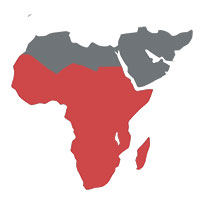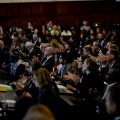Put Out the Climate Fire – for the People
admin | November 18, 2011.
The current pattern of climate change can be compared to a house that’s burning. We’ve been gathering at conferences for 17 consecutive years to negotiate on how to put out the flames, or at the very least keep the house from being burnt completely. Our friends, families and possessions are blazing inside the house, while often we spend more time trying to pinpoint who started the fire. Pretty soon there will be no house – the “greenhouse” will not serve the next generation.
Climate change unquestionably affects our people and by working together towards sustainability, we can reduce these effects. The term sustainability is complex, especially to those of us in developing countries to whom it has become a popular and vital, yet vague term. Most of us speak English as a second or even third language and have no concrete comparative for sustainability in our home languages. Yet, we know we are promoting it, because it is unmistakably the heroine in our fight against climate change.
 To some intellectuals, striving towards sustainability means changes at a grand scale – switching to renewable energy, making use of carbon trade, reducing greenhouse gases, promoting a green economy and negotiating at the 17th Conference of Parties to the United Nations Framework Convention on Climate Change (UNFCCC) in Durban, South Africa from 28 November to 9 December 2011.
To some intellectuals, striving towards sustainability means changes at a grand scale – switching to renewable energy, making use of carbon trade, reducing greenhouse gases, promoting a green economy and negotiating at the 17th Conference of Parties to the United Nations Framework Convention on Climate Change (UNFCCC) in Durban, South Africa from 28 November to 9 December 2011.
For those at the grassroots level, striving towards sustainability means simpler changes and smaller wins – fighting for a reality free from droughts, floods, disasters, unexpected temperatures and crop failures. COP17 coming to Africa at this time brings the hope of finding climate justice.
Why justice? It is predominantly people in developing countries who truly experience variability and climate change. They are on the front lines of change but ironically contribute the least to its causes, such as greenhouse gas emissions.
Zambia tormented by floods
World Bank Country Director Kunda Kadiresan emphasized that floods and droughts are negatively affecting the Millennium Development Goals (MDGs), particularly MDG 1: The reduction of poverty and hunger at a global level. “200 million people are affected by climate change. 300 000 people in Zambia live below the poverty line due to climate change,” she said. “While 75 percent of Africans rely on agriculture, approximately 196 million hectares of the land in Africa is degraded.”

The people of Zambia, like many in other developing countries, are severely affected by the consequences of changing weather patterns. In Changing Rains poor urban planning expose Zambian capital to repeat of 2010 floods, rains in Africa are heavier and fall at different times, while dry periods are growing longer in some regions, wreaking havoc on agriculture.
“Soil and rain are quality inputs you have little to no control over. Climate change is about volatility – a farmer banking everything on one crop, one he sees an investment, depends on his ability to be able to predict what the weather will do and won’t do, because it directly affects both his income and food security,” says Leisa Perch, Policy Specialist in Rural and Social Development at the International Policy Centre for Inclusive Growth.
Earning a decent living from herding or agriculture in a time of unpredictable and unreliable weather patterns is becoming harder, and urban areas often promise alternative incomes. In search of job opportunities and better schooling, people in developing countries “migrate to cities from the countryside, crowd into small areas of land and build unpermitted homes,” which causes them to “block drainage routes with rubbish,” Kambandu wrote.
“About 60 percent of Lusaka’s population lives in compounds or townships, where small, self-built houses crowd against each other, where there are no indoor plumbing or sewerage facilities and where many residents get electricity through unauthorised connections.”
When there are floods, unimaginable living conditions are created in these vulnerable compounds, as Lusaka saw in 2010 and again in 2011. “Water rose above the window levels of many houses, strong currents carried away pieces of market stalls and boys hoisted fishing nets to catch whatever they could from the gullies where, not long before, they had walked to school,” Kambandu wrote.
Because of insufficient or unaffordable infrastructure, residents have to use outdoor pit latrines and rubbish pits, which are flooded during heavy rains, causing the spread of diseases such as malaria and cholera. “Impaired or inconsistent environmental health will start to impact on you and your productivity,” Perch says.
According to Perch one of the solutions to the social problems of climate change is ensuring adequate investment in social adaptation and solutions. “The balance of funding between adaptation and mitigation and the level of investment in each becomes important. It is in adaptation that more visible efforts tend to be made on social issues associated with climate change.” About 65.6 percent of funding currently goes towards climate change mitigation.
Will solutions focused on the poor be taken into account during the negotiations at COP17? And, if there is “a very real suffering of the near one billion people who wake up hungry each day as a result of the environmental damage we have caused,” as Jason Drew explains in his book, The Protein Crunch, why are we still negotiating?












comment